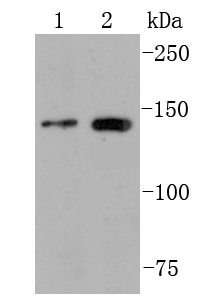Acidic and basic fibroblast growth factors (FGFs) are members of a family of multifunctional polypeptide growth factors that stimulate proliferation of cells of mesenchymal, epithelial and neuroectodermal origin. Like other growth factors, FGFs act by binding and activating specific cell surface receptors. These include the Flg receptor or FGFR-1, the Bek receptor (or FGFR-2), FGFR-3, FGFR-4, FGFR-5 and FGFR-6. These receptors usually contain an extracellular ligand-binding region containing three immunoglobulin-like domains, a transmembrane domain and a cytoplasmic tyrosine kinase domain. The gene encoding human Bek (also designated K-sam) maps to chromosome 10q26.13 and is alternatively spliced to produce several isoforms. Heterogeneous mutations in Bek are associated with a range of craniosynostosis syndromes including Pfeiffer syndrome, Crouzon syndrome, Jackson-Weiss syndrome and Apert syndrome..

